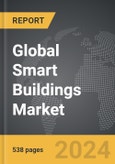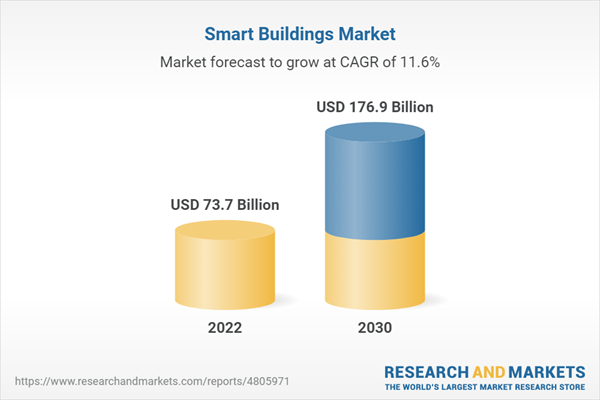Global Smart Buildings Market to Reach $176.9 Billion by 2030
The global market for Smart Buildings estimated at US$73.7 Billion in the year 2022, is projected to reach a revised size of US$176.9 Billion by 2030, growing at a CAGR of 11.6% over the analysis period 2022-2030. Solutions, one of the segments analyzed in the report, is projected to record 10.7% CAGR and reach US$98 Billion by the end of the analysis period. Growth in the Services segment is estimated at 12.7% CAGR for the next 8-year period.The U.S. Market is Estimated at $22.2 Billion, While China is Forecast to Grow at 13.6% CAGR
The Smart Buildings market in the U.S. is estimated at US$22.2 Billion in the year 2022. China, the world's second largest economy, is forecast to reach a projected market size of US$28.8 Billion by the year 2030 trailing a CAGR of 13.6% over the analysis period 2022 to 2030. Among the other noteworthy geographic markets are Japan and Canada, each forecast to grow at 9.2% and 10.4% respectively over the 2022-2030 period. Within Europe, Germany is forecast to grow at approximately 11.1% CAGR.Select Competitors (Total 166 Featured) -
- ABB Ltd.
- Accenture PLC
- Advantech Co., Ltd.
- Avnet, Inc.
- Azbil Corporation
- Automated Logic Corp.
- ADT LLC
- Axonize
- 75F
- Aamidor Consulting
- ATS Automation, Inc
- AtSite
- Bandora Systems
- Amer Group
- BACnet International, Inc.
What`s New?
- Special discussions on the global economic climate and market sentiment
- Coverage on global competitiveness and key competitor percentage market shares
- Market presence analysis across multiple geographies - Strong/Active/Niche/Trivial
- Online interactive peer-to-peer collaborative bespoke updates
- Access to digital archives and research platform
- Complimentary updates for one year
- Access to curated YouTube video transcripts of market sentiments shared by CEOs, domain experts and market influencers via interviews, podcasts, press statements and event keynotes
Economic Outlook
The global economic outlook is improving, and growth recovery, albeit on the lower side, is expected for this year and the next. The United States although witnessing slowing GDP growth in response to tight monetary and financial conditions, has nevertheless overcome the recession threat. Easing of headline inflation in Euro area is helping boost real incomes and is contributing to pick-up in economic activity. China is expected to see strong increases in GDP in the coming year as the pandemic threat recedes and the government sheds its zero-COVID policy. With optimistic GDP projections, India remains on-course to emerge into a US trillion economy by 2030, surpassing Japan and Germany.The upturn, however, remains fragile and a number of interlocking challenges continue to run in parallel, such as continued uncertainty around the war in Ukraine; slower than expected decline in global headline inflation; continuation of food and fuel inflation as a persistent economic problem for most developing countries; and still high retail inflation and its impact on consumer confidence and spending. Countries and their governments are showing signs of weathering these challenges, which helps lift market sentiments. As governments continue to combat inflation to get it down to more economically conformable levels by raising interest rates, new job creation will slowdown and impact economic activity. Stricter regulatory environment and pressure to mainstream climate change into economic decisions will compound the complexity of challenges faced.
Although corporate investments can likely be held back by inflation worries and weaker demand, rise of new technologies will reverse partially this prevailing investment sentiment. Rise of generative AI; applied AI; industrializing machine learning; next-generation software development; Web3; cloud and edge computing; quantum technologies; electrification and renewables and climate technologies beyond electrification and renewables, will open up the global investment landscape. The technologies hold the potential to drive sizeable incremental growth and value to global GDP in the coming years. The short-term is expected to be a mixed bag of challenges and opportunities for both consumers and investors alike. There is always opportunity for businesses and their leaders who can chart a path forward with resilience and adaptability.
Table of Contents
I. METHODOLOGYII. EXECUTIVE SUMMARY2. FOCUS ON SELECT PLAYERSIII. MARKET ANALYSISIV. COMPETITION
1. MARKET OVERVIEW
3. MARKET TRENDS & DRIVERS
4. GLOBAL MARKET PERSPECTIVE
UNITED STATES
CANADA
JAPAN
CHINA
EUROPE
FRANCE
GERMANY
ITALY
UNITED KINGDOM
REST OF EUROPE
ASIA-PACIFIC
REST OF WORLD
Companies Mentioned (Partial List)
A selection of companies mentioned in this report includes, but is not limited to:
- ABB Ltd.
- Accenture PLC
- Advantech Co., Ltd.
- Avnet, Inc.
- Azbil Corporation
- Automated Logic Corp.
- ADT LLC
- Axonize
- 75F
- Aamidor Consulting
- ATS Automation, Inc
- AtSite
- Bandora Systems
- Amer Group
- BACnet International, Inc.
Table Information
| Report Attribute | Details |
|---|---|
| No. of Pages | 538 |
| Published | April 2024 |
| Forecast Period | 2022 - 2030 |
| Estimated Market Value ( USD | $ 73.7 Billion |
| Forecasted Market Value ( USD | $ 176.9 Billion |
| Compound Annual Growth Rate | 11.6% |
| Regions Covered | Global |









